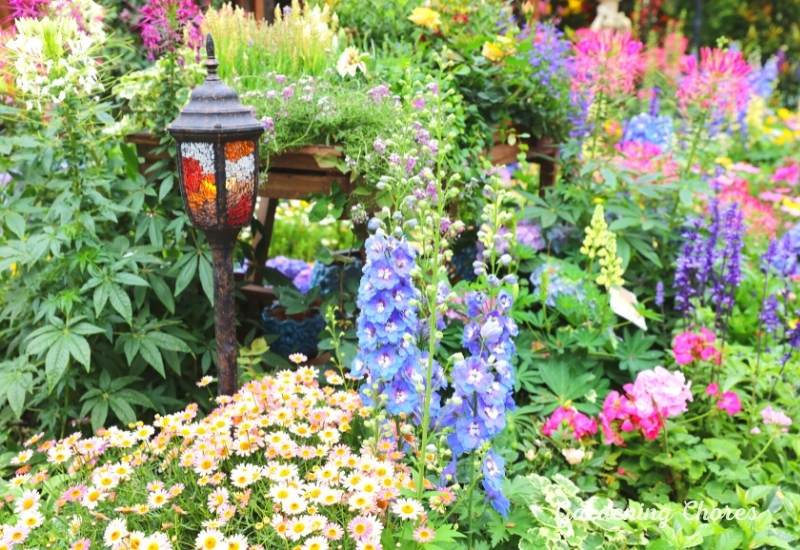
An essential part of a healthy garden is pollinators, and in fact 90% of wild plants and 75% of the world’s top crops depend on pollinators.1 Many insects and animals can pollinate plants, such as butterflies, wasps, bats or hummingbirds, but bees are the most important ones.
Bees pollinate while they fly around to different flowers, storing and feeding on nectar and protein-rich pollen. The plants we grow won’t produce fruit without being pollinated, so every gardener should welcome bees with open arms if they want a good harvest!
But bees are in decline, primarily due to heavy applications of chemical pesticides, habitat loss, and an overall reduction in diverse, nectar rich flowers and plants.
This has serious global impacts, but it affects every home or balcony garden too.
The good news is, there are some easy steps you can take to create a bee-friendly gardens and give nature a helping hand by growing plants with showy, nectar-rich flowers that attract an array of bees.
This article will help you to help bees by outlining some important tips and a list of annuals and perennial flowers to plant that encourage bees to come into your garden.
Characteristics of Bee-friendly Flowers
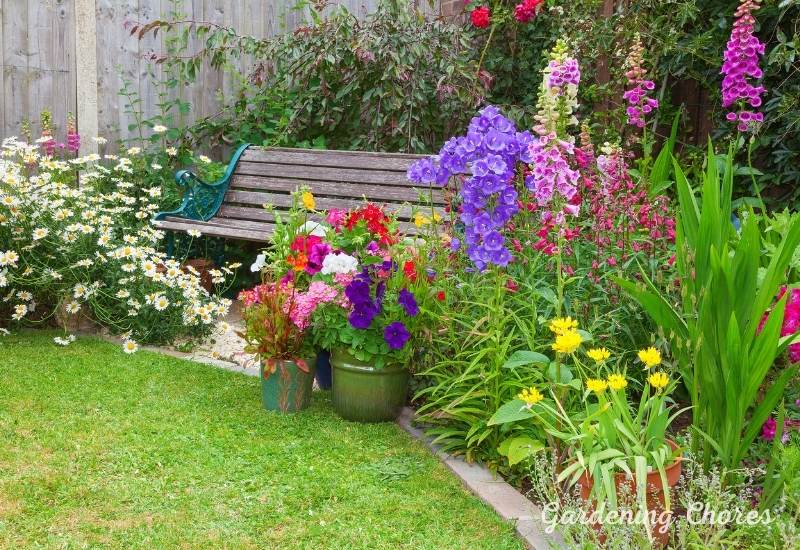
Here are four factors to consider when choosing flowers that are most attractive to bees:
25 Flowering Plants That Attract Bees to Your Garden
So which flowers should you plant to encourage bees to come and pollinate your plants? Here is a list of 25 common flowers you can plant to attract hordes of happy bees to your garden.
Bee-Friendly Annual Flowers for Your Garden
Annual flowers will just survive one growing season and need to be planted again the next year, however many varieties will self-seed and come back without help!
Here are the 5 of the best annual flowers that are particularly beloved by bees.
1. Borage
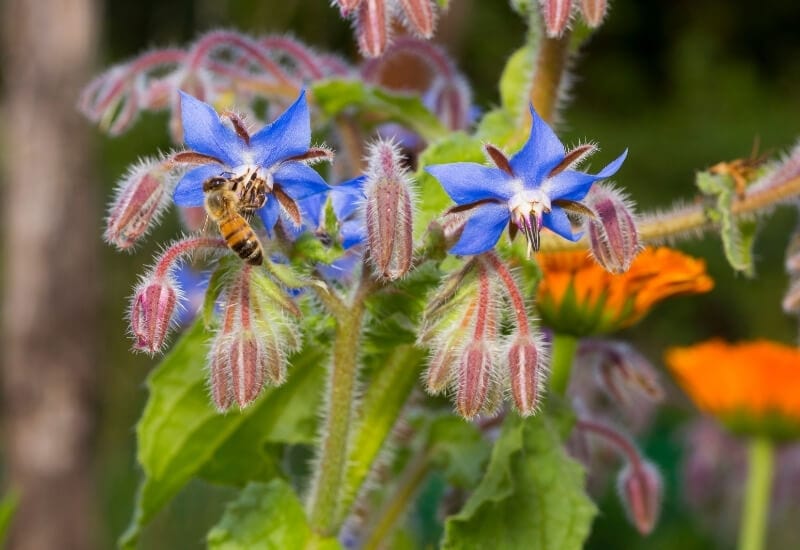
Why do bees like it? Borage flowers bloom throughout the season and frequently replenish their nectar sources, which provides bees with a stable food source for months.
Borage flowers hang down, which means if there is a period of rain that washes the nectar out of your upward facing flowers, the bees will still be able to feed from the borage.
One of the most renowned bee-attracting plants, borage is native to the Mediterranean and it will self seed in the same spot of your garden every year.
2. Cornflower
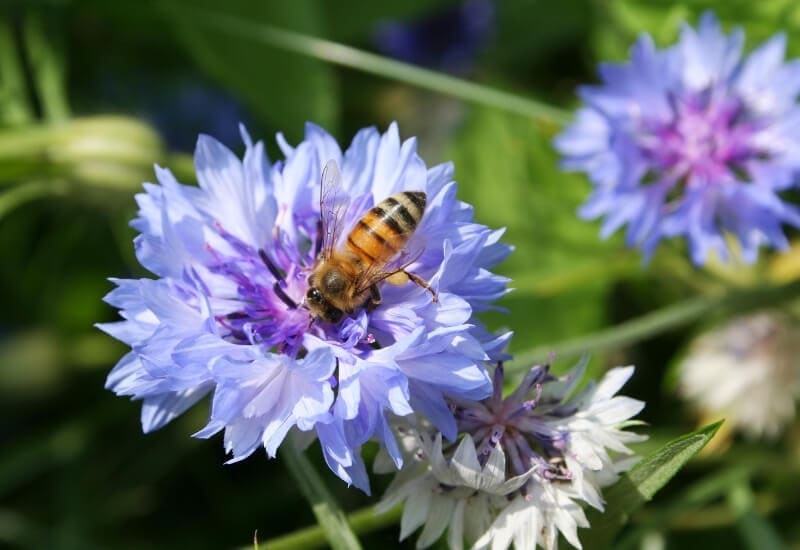
Why do bees like it? The blue flowers create a beacon for the bees to instantly register and fly to (‘beeline’ if you will). These flowers also have the added bonus of producing nectar from nectaries (part of the flower that produces nectar) on the unopened buds and seed heads, meaning that bees can benefit from their presence before and after they have bloomed.
Cornflowers, or bachelor’s button, are popular annuals as they can be grown in less than ideal soil and weather conditions.
Their name comes from their history as a hardy weed that would pop up in corn and wheat fields, instantly recognizable from their spiky flowers.
3. Cosmos
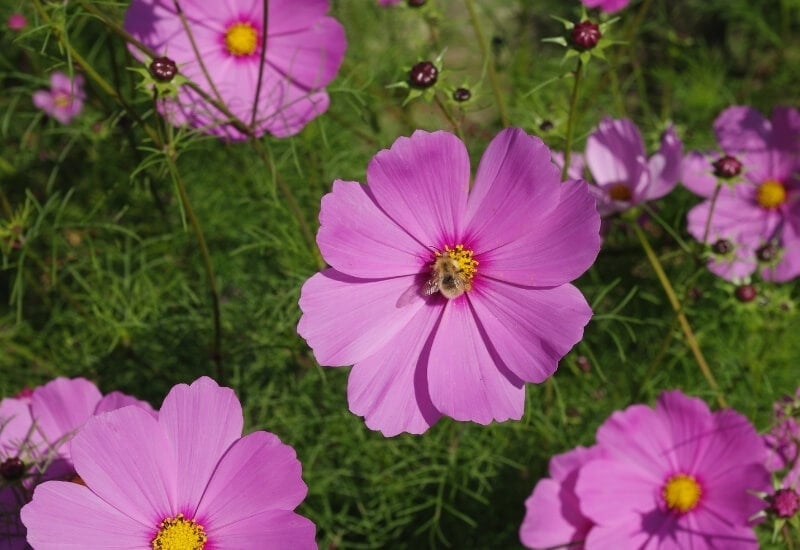
Why do bees like it? Many pollinators including bees love cosmos flowers, because they are so open and provide super easy access to their tasty centre filled with pollen and nectar.
There is no need for a bee to wiggle and crawl into the centre of the flower with these (although it’s very cute when they do).
In the same family as sunflowers, cosmos are drought tolerant annuals that give a very cottage-y feel to a garden. They come in a whole sleuth of colours and are native to the Americas.
4. Snapdragon
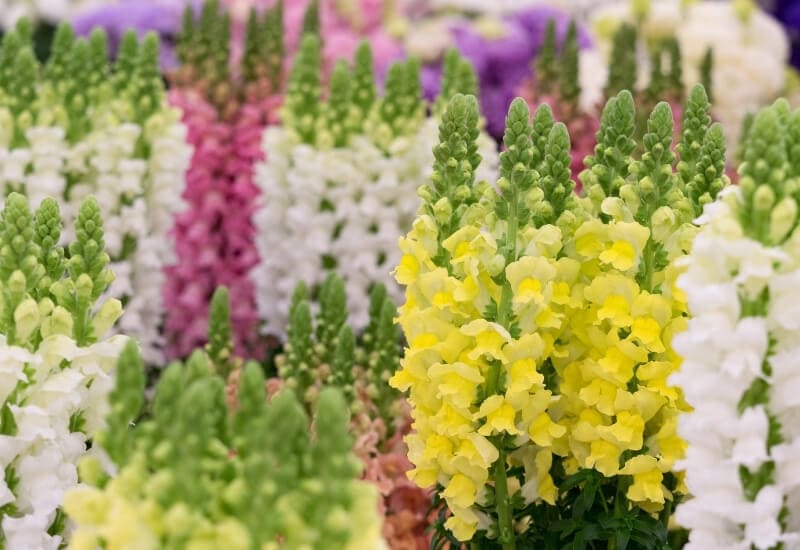
Why do bees like it? Snapdragons attract bees because they release their powerful scent during the day, which is when bees are most active in the garden. Additionally, their bell shape provides a great nook for them to crawl into while feasting on nectar.
Snapdragons are cool season annual flowers native to many continents across the world. They enjoy cool, moist soil and commonly bloom in the early summer or late spring.
5. Zinnia
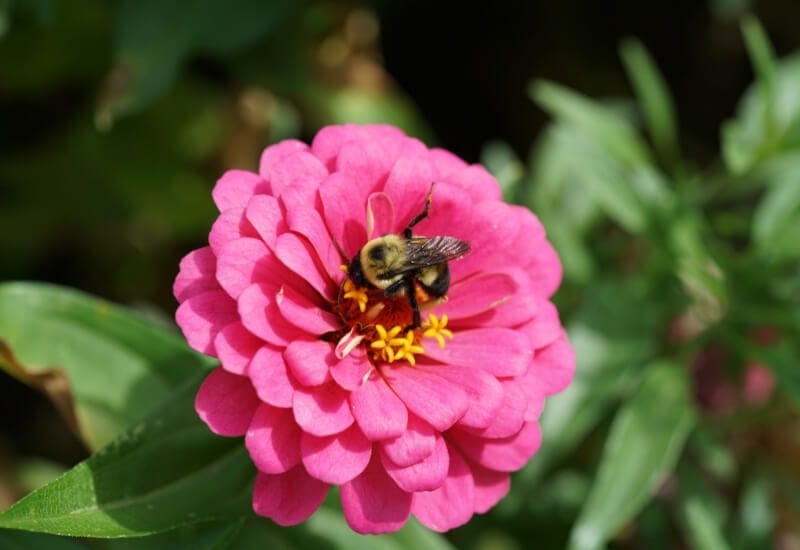
Why do bees like it? Zinnias are a favorite of many pollinators due to their nectar rich flowers.
Even the red zinnias attract bees, even though bees cannot see red, likely due to their ultraviolet markings on the petals. They are also conveniently low maintenance.
Zinnias are native to the Americas and come in many shapes and colors. They need full sun and soil that is rich in organic matter. Choose single flowering varieties for bees.
recommends Bee Friendly perennials
Unlike annuals, perennial flowers last many seasons and will return every spring, along with the bees!
Here are the 20 perennial plants and flowers to bring bees to your garden.
6. Anise Hyssop
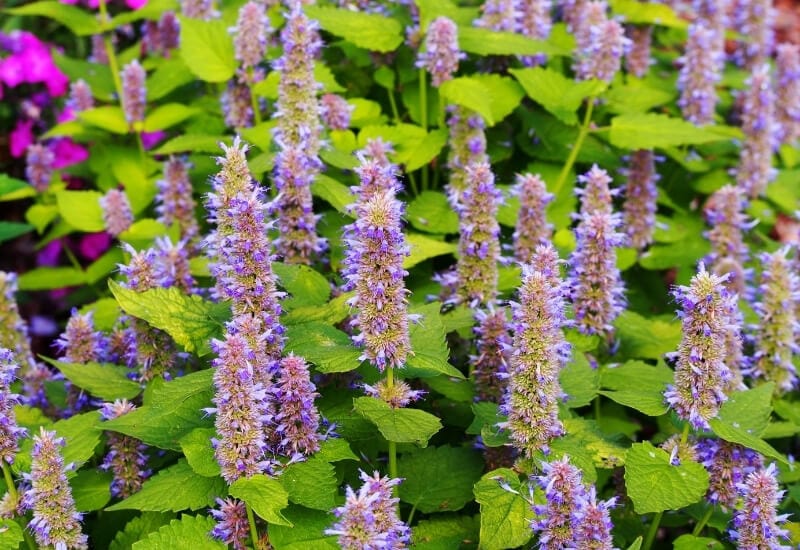
Why do bees like it? As a member of the mint family, Anise Hyssop (which tastes like licorice) contains something called methyl eugenol in its nectar and pollen, which is highly nutritious for bees.
It also has antibacterial and antifungal properties that keep the hives healthy. The dark blue flowers also attract the bees.
Best suited to USDA Hardiness Zones 4-9, it is widely used for medicinal and herbal purposes.
7. Apple Tree Flowers
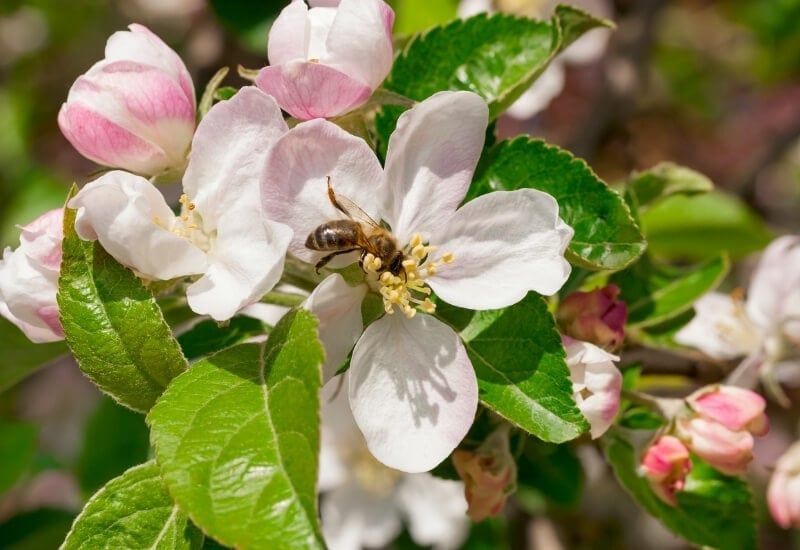
Why do bees like it? Providing both pollen and nectar for hungry bees, apple blossoms are great for bee friends. Elect a cross-pollinating variety as the bees are less interested in the self-pollinating ones.
When apple trees bloom, their red buds burst into white and pink flowers. Bloom time differs depending on your region and variety of tree, but is usually mid to late spring.
8. Catnip
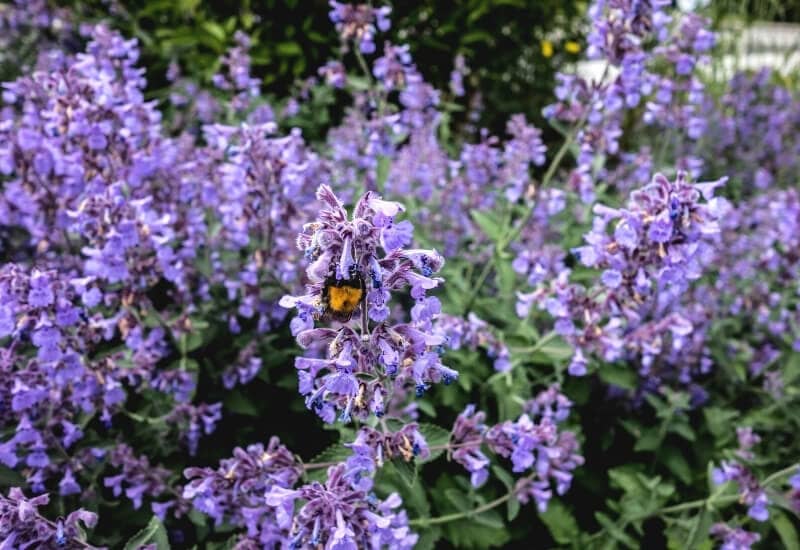
Why do bees like it? Disliked by mosquitoes but loved by bees- what more could you want from a plant? Catnip has lots of tiny flowers providing ample sources of nectar for honeybees to feed on.
Known for its popularity with cats, catnip is another member of the mint family that will self seed every year and take over your garden if not kept under control.
Aside from making cats a little tipsy, it has medicinal uses for humans and is often brewed as a tea.
9. Chives
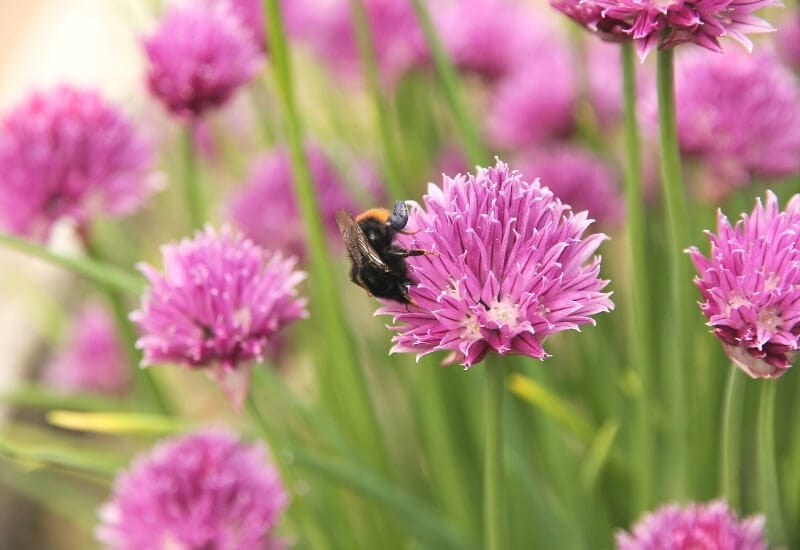
Why do bees like it? Chives will pop back up earlier than most plants while the weather is still cool.
This means when it’s finally warm enough for bees to come out of their hives, there are already open chive flowers full of nectar for them to feast on. The flowers are also purple which bees love.
Chives are a perennial herb in the Allium genus, which also contains onions, garlic and leeks.
Easy to grow and with edible stalks and flowers, Chives are a staple of many gardens as they require very little maintenance.
10. Foxglove
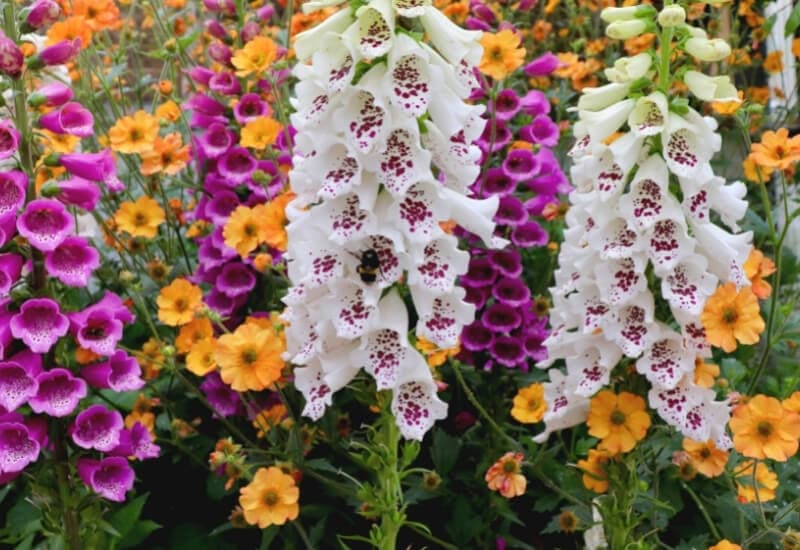
Why do bees like it? Not only does the pinky-purpley-blue color palette of foxgloves suit bees, but their trumpet shaped flower is actually evolutionarily designed to let bees climb inside with folded wings and be protected while they drink up nectar.
If you don’t already know, foxglove is very poisonous if ingested and poses a serious hazard for pets and children who might unknowingly eat it.
11. Goldenrod
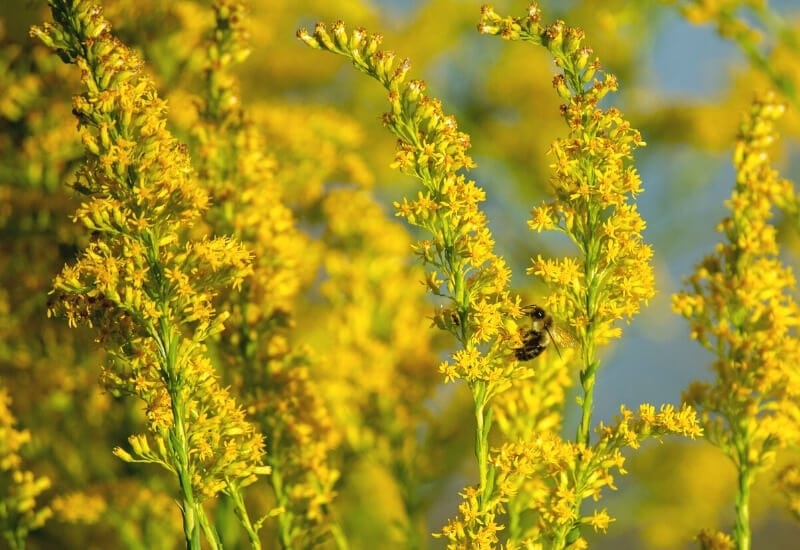
Why do bees like it? Goldenrod rushes in at the end of the season throughout the autumn, when many plants are no longer flowering and the food sources are running low for bees.
Since this is when many beekeepers are harvesting honey from hives, having Goldenrod planted allows the bees to make some last honey reserves before they get shut in for the winter.
Native to prairie regions across the world, many species of Goldenrod grow wild and abundant along the side of roads and in fields.
It is a hardy perennial that needs very little maintenance beyond the occasional watering.
12. Honeywort
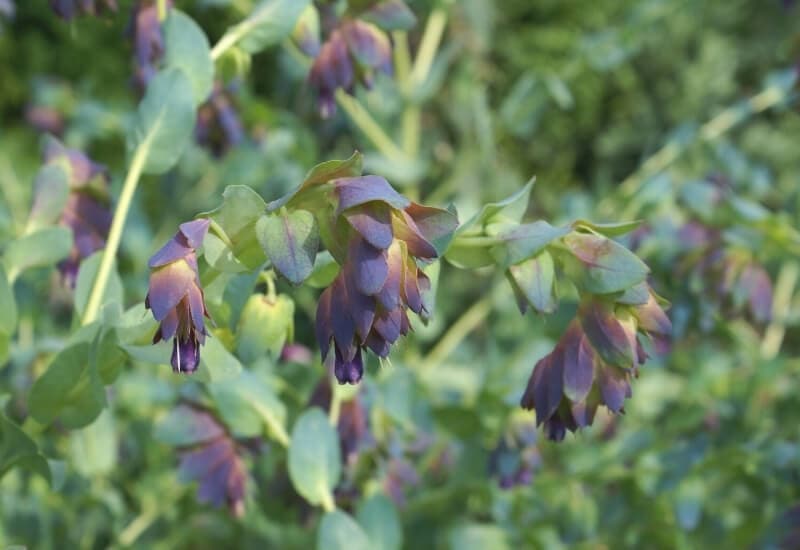
Why do bees like it? The flowers of this aptly named plant bring the bees swarming in because of its rich nectar, and the nectar itself is said to already taste like honey. Hummingbirds like this plant too.
A very unique looking flower that is native to the Mediterannean region, Honeywort has leathery blue and purple flowers that intensify in colour in the fall.
13. Lavender
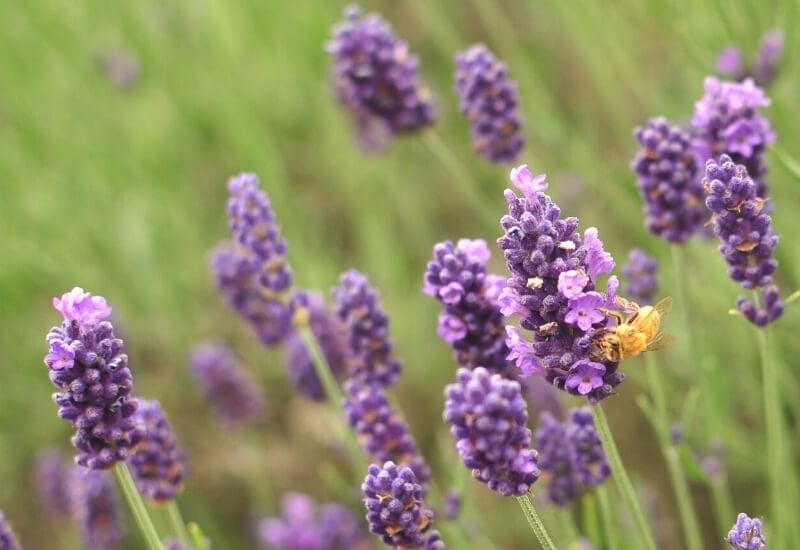
Why do bees like it? Its fragrant smell and tall purple perennial flowers are recognizable to bees from far away, and the bush-like manner in which it grows with many flowers on one plant creates a cornucopia for the bees to hop from one flower to another.
Bumblebees have been found to prefer it to honeybees, as their extra long tongues can maneuver in to lick the nectar more easily.
Another famous bee magnet, lavender is popular across the world for its aromatic scent and oil that is pressed and used in many products.
Native to Europe, Asia, and Africa there are many species of this plant, many of which are hardy to drought and poor soil.
14. Lupine
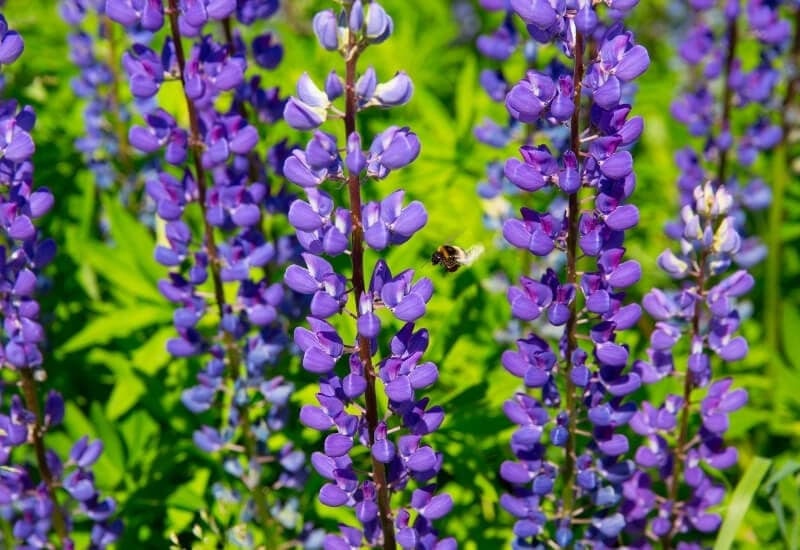
Why do bees like it? The lupin flowers are similar to lavender in that they also attract bumble bees and mason bees more than the famous honeybee, as their slightly heavier weight bends the flowers when they land and provides great access to the nectar.
A member of the legume family, there are many species of lupine that span the Americas and most of them are perennials.
15. Mint
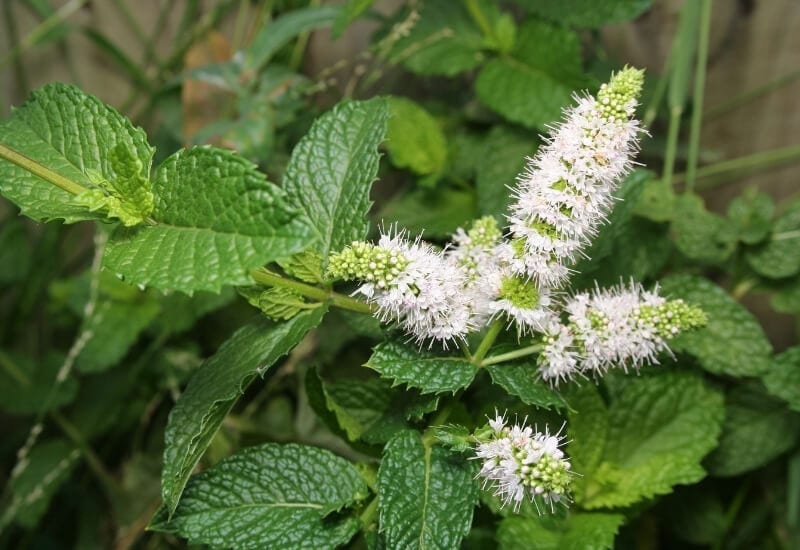
Why do bees like it? Bees are attracted to the different kinds of mint flowers because of their powerful scent and rich nectar.
Mint flavored honey can even be made if the bees are exclusively collecting nectar from mint species.
There are many kinds of mint you can grow, and luckily bees love them all! There is a lot of cross breeding between different species, but some of the most popular ones are peppermint, spearmint and chocolate mint.
16. Marigolds
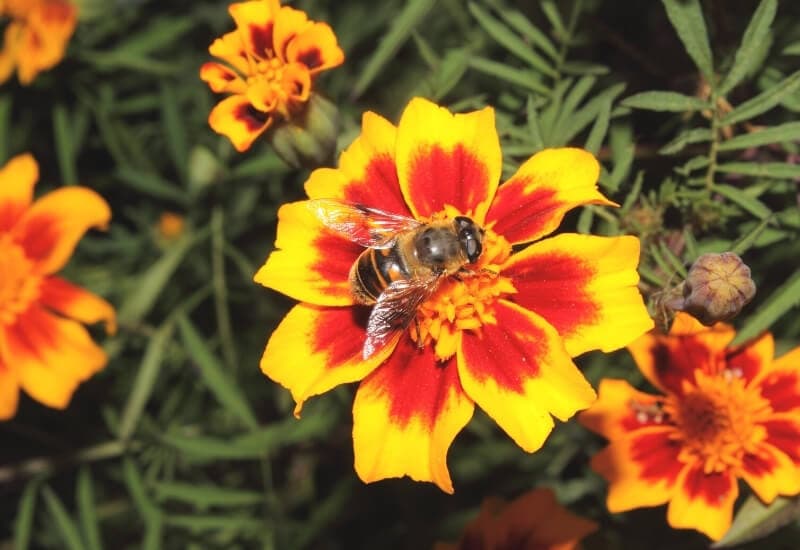
Why do bees like it? They bloom all season and provide many bee species with a constant flow of nectar and pollen, but they are known to deter wasps and other carnivorous insects who aren’t drawn to their scent.
Marigolds are native to Mexico but have spread to home gardens around the world due to their cheery and colorful flowers. Marigolds are known for their insect-repelling capabilities, but it is a myth that they repel bees.
17. Monarda
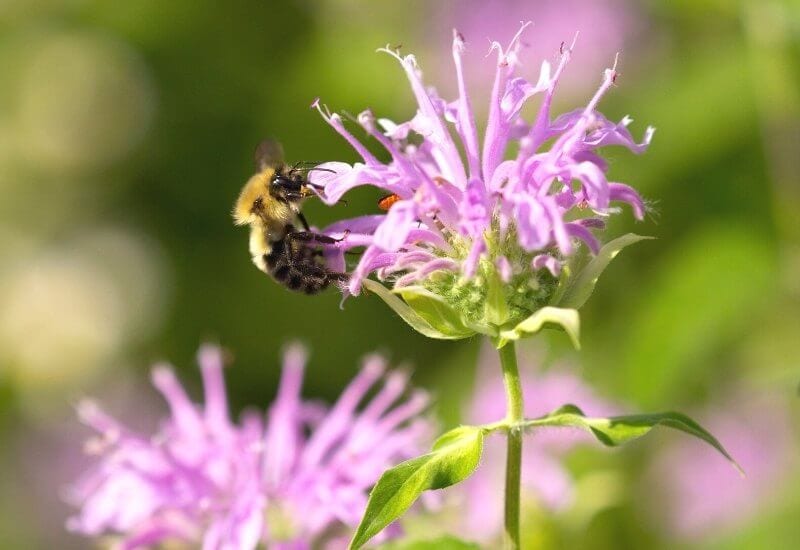
Why do bees like it? Bees adore Monarda due to its powerful and fragrant smell. It’s common name of bee balm came from its use as a traditional medicine to treat bee stings when crushed up.
Also known as wild bergamot or bee balm, Monarda is a perennial native to north america. It is another member of the mint family and needs lots of sun and well-draining soil.
18. Nasturtium
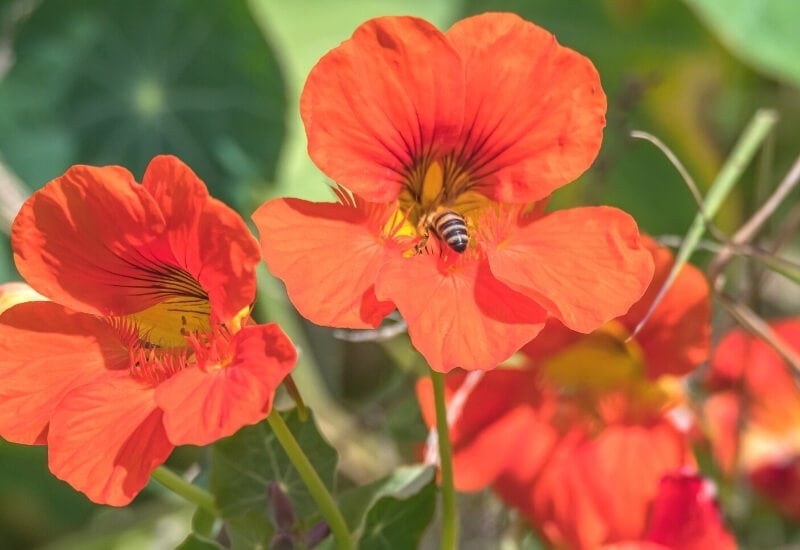
Why do bees like it? Nasturtiums are beloved by many bees, but particularly popular with bumblebees because of their open shape which acts as a landing platform for bees to access the rich pollen inside.
Many flowers will bloom on one plant, especially if you keep cutting the heads (called deadheading).
Nasturtiums are edible flowers that have a slightly peppery flavour. They can be bushy or climbing and are popular window box flowers due to the cascading leaves.
19. Oregano flowers
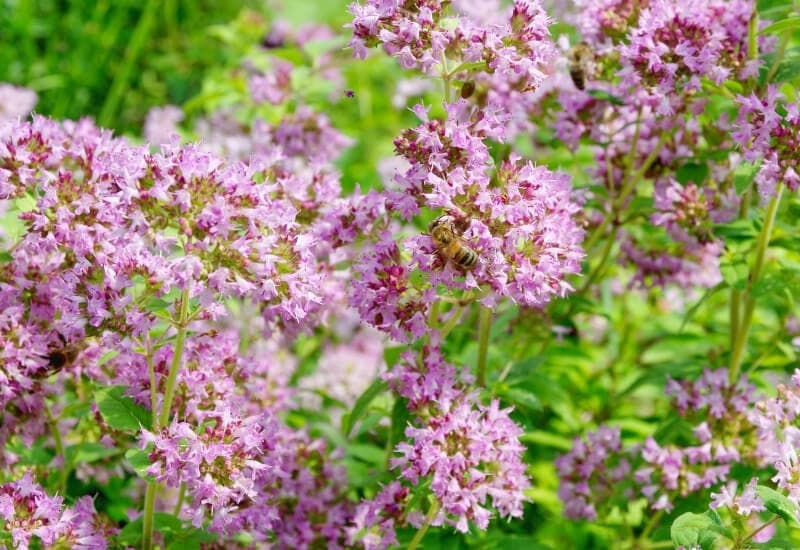
Why do bees like it? Oregano blooms in the height of summer, which is when bee colonies are at their largest capacity and there are a lot of hungry bees to feed.
It’s also very rich in nectar and fragrant, making it an all round great addition for bees and butterflies too.
Most well known as herb, oregano can be eaten fresh or dry and the plant is native to Europe and the Mediterranean. The flowers are also edible but the leaves can become a bit more bitter if harvested after blooming.
20. Peonies
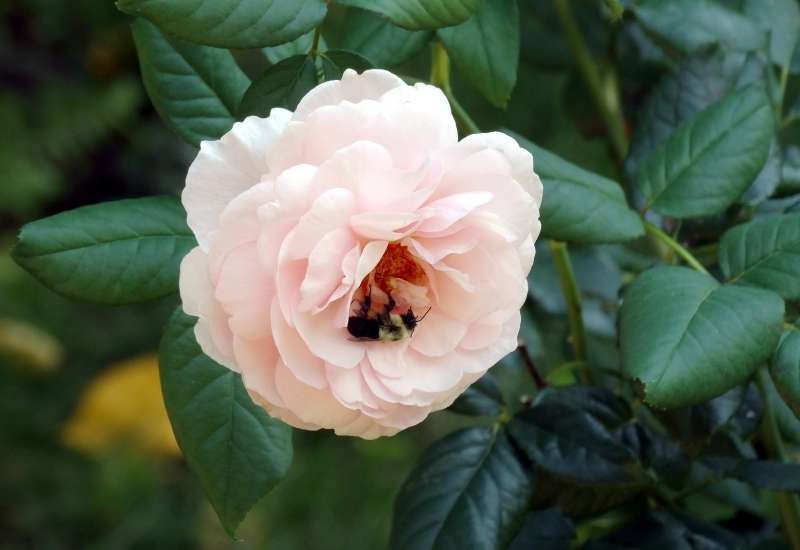
Why do bees like it? Single peonies are the most popular with bees, as they have lots of protein rich pollen and the bees can access it with relative ease.
Some of the double and exotic varieties of peony have too many petals for the bee to be able to easily access the center.
21. Poppies
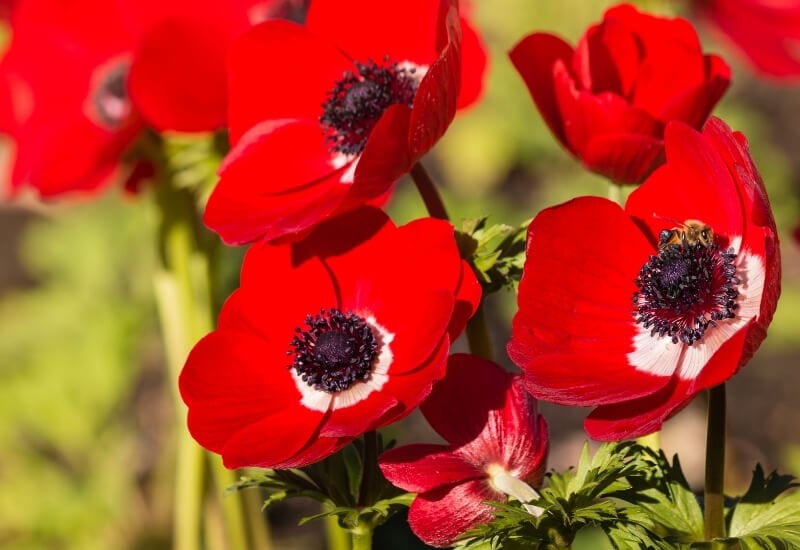
Why do bees like it? Although poppies don’t produce sugary nectar, bees like them because of their rich pollen sources. The poppy mason bee even uses its petals to line its in-ground nests.
Poppies grow well in full sun but can tolerate poor soil, even soil as inhospitable as found on war battlegrounds, which is why they are symbolic of commemorating fallen soldiers.
22. Salvia
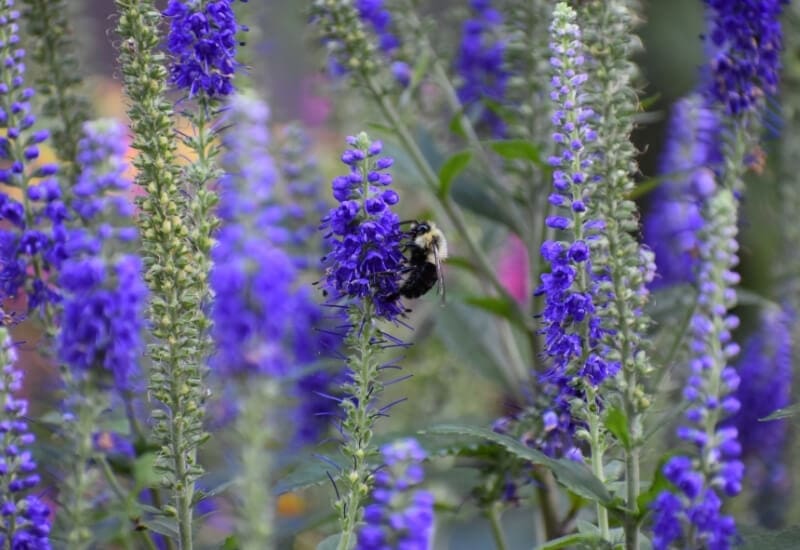
Why do bees like it? Bees are particularly attracted to the purple flowering varieties of sage, and it is especially popular amongst bee species with longer tongues that can maneuver into the spiky purple flowers.
Commonly known as sage, salvia is a perennial, woody shrub with flowers that come in many different colours. To get maximum flower growth, grow salvia in full sun and in soil with good drainage.
23. Sunflower
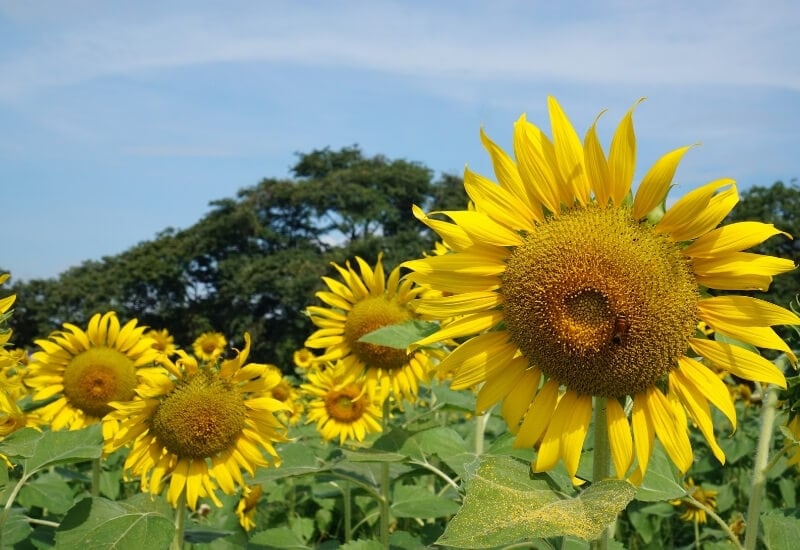
Why do bees like it? The huge heads of sunflowers are landing strips for tired bees that happen to be filled with tubes of nectar.
The discs at the centre of sunflowers provide easy access and ample food for many bees to feed from the same flower at once.
Sunflowers are iconic flowers that can grow very tall and develop giant heads. They will angle themselves to face the sun, so make sure you plant them in a suitably sunny spot.
24. Sweet Alyssum
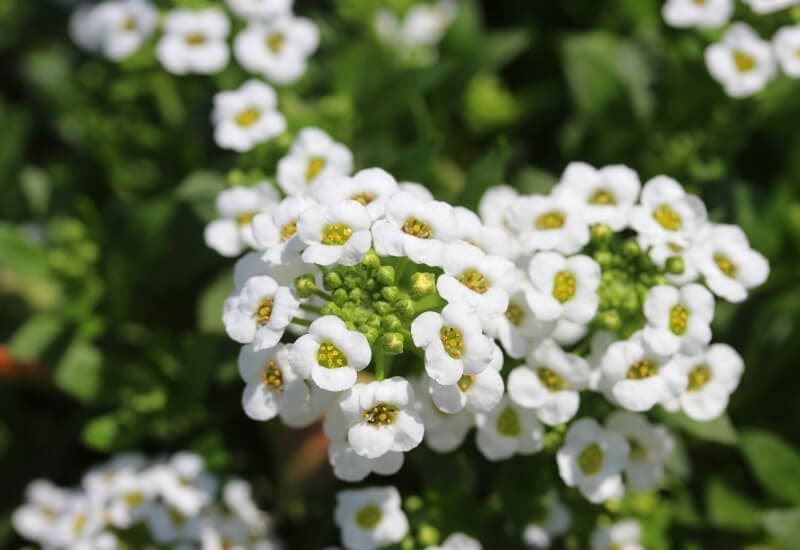
Why do bees like it? The dozens of purple and white flowers are great for attracting bees. Bees can see purple very clearly so purple flowers encourage them to come to that plant.
Sweet alyssum is very low growing and produces a carpet on many tiny flowers. Grow in well draining soil with good sun exposure, but the flowers can tolerate some shade.
25. Thyme Flowers
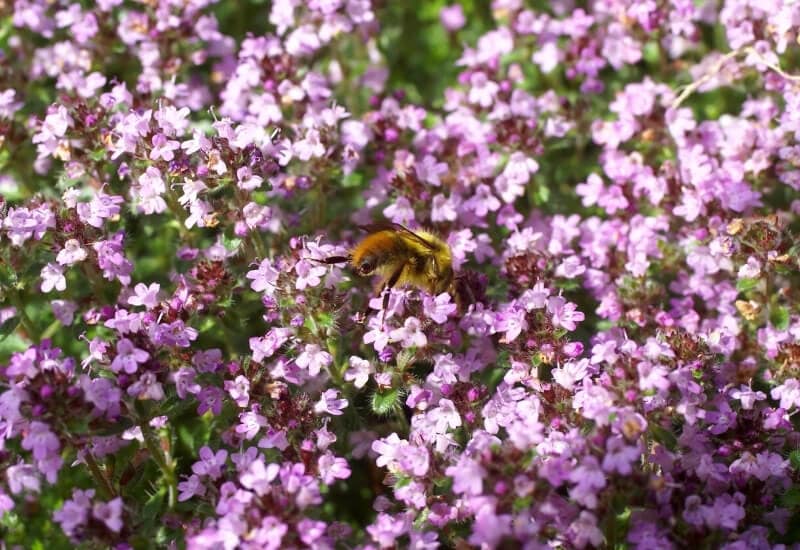
Why do bees like it? Thyme has little flowers that carry a powerful scent, and many species of bee are attracted to it. The flowers can be lavender colored or white, and attract butterflies as well.
Thyme is a popular staple of herb gardens, and is quite drought tolerant and loves heat. Harvest leaves early on and then avoid trimming your bush so that it flowers in the summer.
6 Tips To Attract More Bees To Your Garden
In addition to planting flowers that attract bees, there are several other ways to support pollinators from your own garden.
Here are 6 easy gardening tips to help bees and to attract them to your garden.
1: Avoid Using pesticides That Are Toxic To Bees
Pesticides are a large part of the reason for the global decline in bees, and are very harmful to many other pollinators and wildlife in general.
Even organic pesticides can be toxic to many helpful critters, so consider using holistic pest management techniques like crop rotation, companion planting, hand-picking, and row covers to control pests.
2: Plant Native Species
Native bees are in peril as much as the famous (and in North America, invasive) honeybee, and planting wildflowers and native plants in your backyard provides them with their natural food source and nest building materials.
Honeybees are great but we want to ensure they aren’t muscling out their native counterparts by only planting their favorite flowers.
3: Encourage Diversity By Including A Wide Variety Of Flower Shapes
Fill your garden with a wide variety of species that flower at different times of the year, benefiting the life cycles and feeding requirements of many pollinators such as butterflies or hummingbirds.
Evolutionarily, diversity is resilience, and this applies to your garden as well. One drought or disease is less likely to wipe out your whole garden if you have many types of plants growing that have different strengths and tolerances to adverse conditions.
4: Provide A Water Source
Having a shallow dish of water for thirsty pollinators to drink from can make a world of difference.
Add rocks that stick out above the water level so that there is a perch for insects to land on. If you already have a bird bath, that will work fine.
5: Leave Dead Tree Stumps In Your Garden
In wild environments, dead trees provide a habitat for a whole troop of insects, animals, and fungi, but we often want to get rid of them and take away this essential service.
Consider leaving an old tree stump in your garden for wood-burrowing bees and other insects that will in turn pollinate your garden.
6: Educate Friends And Neighbors
Helping pollinators begins with education. Many people might not be aware of how synthetic pesticides hurt more than the pest they are going after, and especially how no pollinators means no fruit!
Join a local conservation group, and tell friends, family, and neighbors what you now know about bees. If neighbors are hurting local bee colonies it will affect your garden too.
Enjoy your buzzing garden
Once you have planted some of these flowers to create a bee-friendly garden, make sure to take a moment to enjoy the sounds and smells and life that are the result.
The gentle hum of bees buzzing while they do their work, butterflies fluttering through the air, maybe a hummingbird swooping down.
These are all signs that your garden has become a little ecosystem, with you and your family at the heart of it, supporting local wildlife in a mutually-beneficial cycle that will continue for years to come.
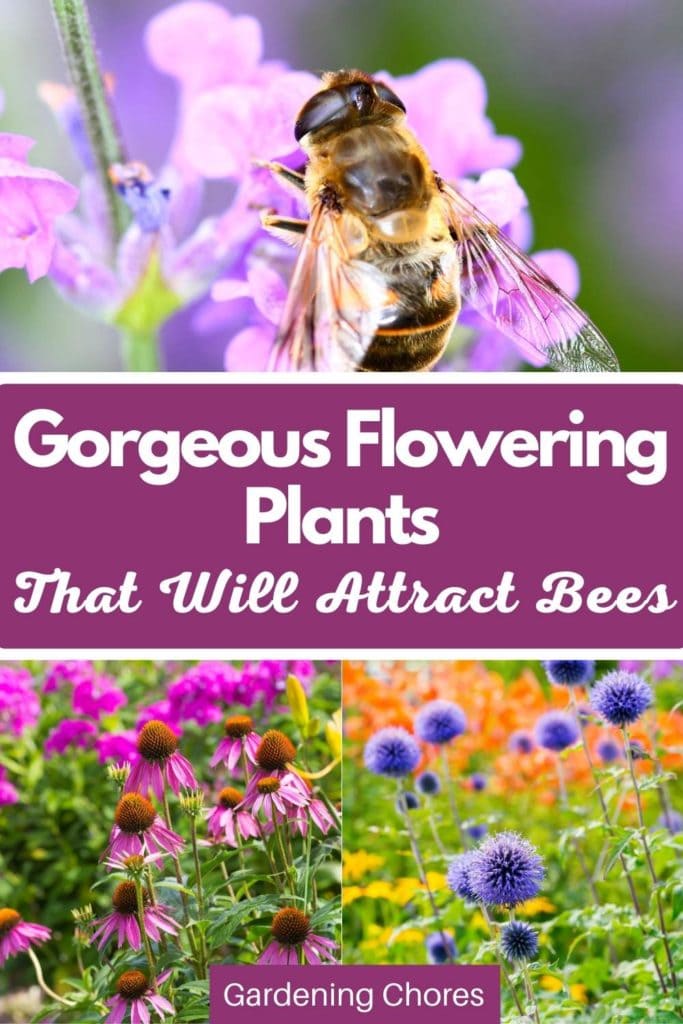

Written By
Margie Fetchik
Margie and Arkansas native has an extensive background in gardening and landscaping. For the last 40 years, Margie has called the Colorado Rocky Mountains her home. Here she and her husband of 36 years raised three kids and owned a successful landscaping company. Margie has a CSU Master Gardener certification. She specialized in garden design & installation, perennial gardens, turf grasses & weeds, flower containers, and the overall maintenance of allHOA, commercial and residential accounts. She and her husband now reside in Denver and are excited about the new experiences’ city life holds.
